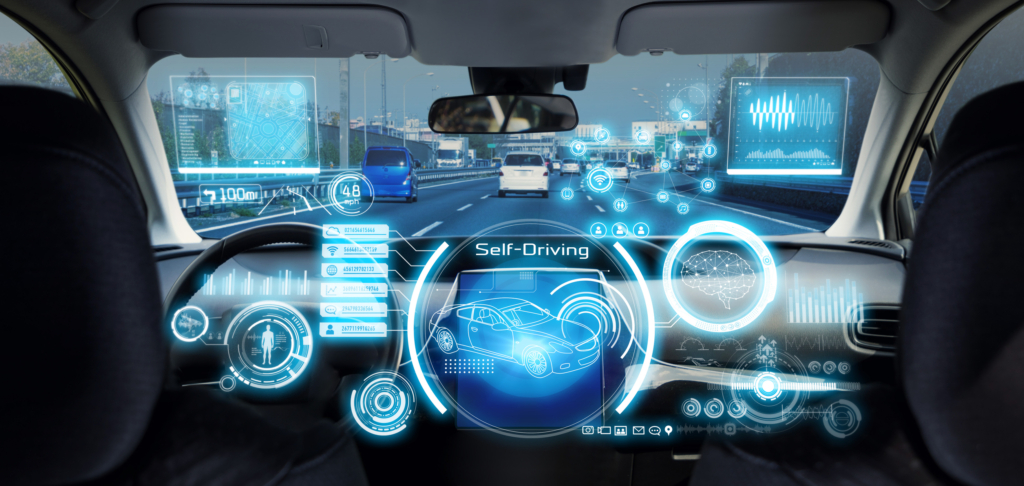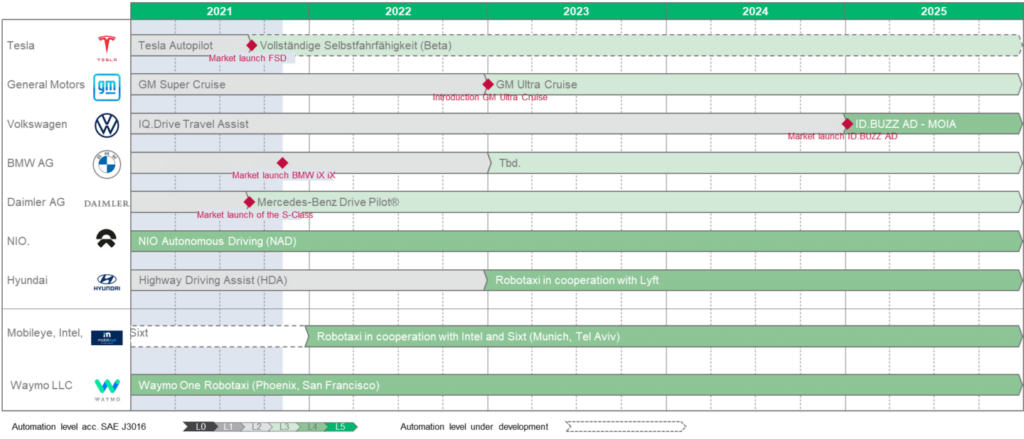Publication
Autonomous driving: this is what the (automotive) industry is really like
“The driverless car will already exist in five years”[1] was the headline of an article in the newspaper WELT in 2015 and was only one of many announcing autonomous driving for the beginning of the 2020s. In 2017, the German government passed the Automated Driving Act. In July 2021, the law on autonomous driving followed, which in principle allows the operation of autonomous vehicles on public roads nationwide.[2] Apart from individual pilot projects, however, autonomous driving is still far from being present in everyday life today. There are many reasons for this and the whole project faces immense challenges.

Autonomous driving: The whole world is talking about it, but what exactly does it mean?
In future mobility scenarios, autonomous driving is often a central component that is intended to make everyday traffic safer and more efficient. However, this does not always mean fully autonomous vehicles that take passengers to their destination. Even partial automation of vehicles could add considerable value to road traffic in terms of safety and efficiency. To classify autonomous driving capabilities in vehicles, the Society of Automotive Engineers (SAE) International has defined a total of six automation levels in the SAE J3016 standard. With the publication, a standardised industry-wide comprehension of the different levels was created.[3] A central criterion of the standard for differentiating the levels is the role of the driver while driving.
The six automation levels on the path towards autonomous driving.
Below we outline the six levels 0-5 based on their equipment characteristics and autonomous capabilities.

Automation Level 0-1
Fahrzeuge des Level 0 sind ohne fahrassistierende Funktionen ausgestattet. Ein Fahrzeug mit integrierten und isoliert verwendeten AsLevel 0 vehicles are equipped without driver-assist functions, whereas a vehicle with integrated assistance systems used in isolation, such as a cruise control or lane departure warning system, falls under Level 1 (Assisted Driving).
Automation Level 2
Semi-automated driving (level 2), on the other hand, combines individual assistance systems of assisted driving and enables certain driving activities and manoeuvres to be carried out without the driver’s intervention. This level is achieved by Tesla Autopilot® , although this feature name suggests a supposedly higher level. The US electric vehicle manufacturer combines a proximity control system with a lane departure warning system in its vehicles, thus enabling only assisted driving in accordance with the standard. In the first three levels, the driver is only assisted after activating the assistance systems as described. It is possible to temporarily take your hands off the steering wheel, but the driver must be able to monitor the operation and take control of the vehicle at any time.
Automation Level 3
The differentiating feature to level 3 and beyond is that the driving task in certain traffic situations is not carried out by the driver but by the driver assistance systems. The driver may temporarily turn away from the driving activity.[4] This is made possible, for example, by the Drive Pilot® in the Mercedes-Benz S-Class (2021), which takes over vehicle guidance in heavy traffic or in congestion situations at speeds of up to 60 km/h.
Automation Level 4
Level 4 operation of a vehicle differs from level 3 in that here, subject to compliance with certain framework conditions, vehicle control no longer has to be transferred to the driver. So-called Robotaxis, such as those currently offered by the Google subsidiary Waymo LLC in Phoenix and San Francisco, are assigned to this level. Both Level 3 and Level 4 vehicles enable automated or fully automated vehicle guidance only if certain framework conditions are met and in limited areas. This is, for example, when driving on motorways in heavy traffic up to max. 60 km/h (Level 3 operation) and, in the case of Waymo Robotaxi’s localised service, in the suburbs of Phoenix due to the very predictable dry climate, good road conditions and favourable traffic patterns (Level 4 operation).
Automation Level 5
The highest level is reached when vehicles are able to drive independently, regardless of the traffic situation and geographical limitations, and without any intervention by the driver. We are then talking about level 5 vehicles and autonomous driving. Level 5 is currently a theoretical ideal state. Level 3 and 4 are currently prioritised in the development.
The automotive industry and its non-automotive competitors: The status quo
The achievement of automated and autonomous driving requires a complex interaction of different advanced driver assistance systems (ADAS) as well as powerful computing units for data processing. Due to the increasing complexity resulting from the integration of high-resolution sensor systems and the high demands on data processing, companies outside the automotive industry are increasingly entering the market. These include tech and mobility companies such as Google subsidiary Waymo, semiconductor company Intel Corp. or graphics processor specialist Nvidia Corp., which have already become notable players in autonomous driving. Apple is also reportedly considering market entry with its own vehicle.[5]
At the same time, established and renowned companies in the automotive industry are increasingly realising that fully automated or autonomous driving exceeds their competencies. As a result, car manufacturers and suppliers are looking to join forces with tech companies and mobility service providers. For example, Volkswagen AG is cooperating with Argo AI LLC, a company specialising in autonomous driving, to develop the self-driving taxi shuttle VW.ID BUZZ AD (Autonomous Driving). Daimler AG is working with Nvidia , a leading technology company for graphics card technology, to equip its own driver assistance systems with the US company’s technology.[1] The first deployment is planned for 2024 as part of a new vehicle architecture. [6]
AAt this year’s IAA Mobility, the car rental company Sixt in cooperation with the Intel subsidiary Mobileye, two companies outside the vehicle manufacturing industry, announced the operation of a self-driving taxi service as early as 2022. Our illustration provides further examples of current collaborations and progress in the field of automated and autonomous driving.

Key challenges in the field of automated and autonomous driving
Technological complexity
A key challenge of automated or autonomous driving is the technological complexity and maturity of the vehicles and the integrated systems. The driver assistance systems used in the vehicle must ensure impeccable detection of the surroundings and objects at all times, as well as the correct interpretation of every traffic situation, regardless of weather conditions. To this end, already proven systems such as lane departure warning systems are being networked and supplemented with the latest generation of highly complex sensor systems for detecting the vehicle periphery, which include so-called LiDAR sensors (light detection and ranging). The intelligent system combination of camera, radar and LiDAR sensors creates a comprehensive 360° view around the vehicle. Along with the use of these systems is the need for high computing power in combination with the use of artificial intelligence to process the volume of data generated during the journey.
At the same time, the amount of software and electrical/electronic components in vehicles are generally increasing, as the signals and data from the driver assistance systems have to be processed and the drive, steering and braking systems controlled accordingly. Mastering this system complexity poses enormous challenges for the entire industry.
From a technological perspective, automated or autonomous driving is still in its infancy. In addition to technological maturity, a globally uniform regulatory framework and acceptance of autonomous driving are further challenges. Since July 2021, Germany has been the first country in the world to have a law that allows autonomous operation in certain applications on public roads. However, according to the law, a driver must be ready to take over at any time. This principle is prescribed by the Vienna Convention on Road Traffic of 1968, which states that every vehicle requires a driver.[1] The case where all vehicle occupants are passengers and there is no driver in the vehicle has not yet been specified internationally.
Legal frameworks
Furthermore, existing national legal frameworks must be aligned globally. Currently, different regulations exist in EU member states and individual US states. The German law on autonomous driving is therefore considered a transitional solution until there are internationally standardised regulations. For Renata Jungo Brüngger, Member of the Board of Management of Daimler AG for Integrity and Legal Affairs, this legal certainty is a central step that will simultaneously increase the acceptance of automated as well as autonomous driving.[1] This is because social opinion as well as trust continue to be burdened for example by accidents caused by faulty object recognition.
At the same time, the industry also faces recurring ethical issues in the event of an accident. An automated vehicle may take evasive action in certain situations to avoid a collision, but in doing so it may endanger other uninvolved road users. This is ethically controversial, because the accident behaviour of an autonomous vehicle and the possible resulting damage, for example to (uninvolved) persons, is predetermined in the development phase of the advanced driver assistance systems.
The road to autonomous driving in everyday life is and remains a long
The everyday use of fully automated driving therefore still has a long way to go. Therefore, for many people the first ride in a fully automated or autonomous vehicle will probably be through a mobility service. The high costs of the necessary driver assistance systems initially limit automated driving of private passenger cars to luxury class vehicles. Volume vehicles will not be equipped with such features in the short and medium term. At the same time, a shift in awareness towards the sharing economy is emerging, in which owning your own vehicle (or other consumer goods) is becoming less important.[9]
At the same time, the demand for flexible mobility services such as ride-hailing is increasing in general.9 This eliminates the general fixed costs of vehicle ownership as well as obligations such as repairs or tyre changes. This trend is supported by increased environmental awareness among the population[10]. It is therefore highly likely that fully automated or autonomous driving can initially only be experienced through public mobility services. In all likelihood, these offers will continue to exist until 2025. However, it will take many years before autonomous vehicles make up a significant share of road traffic. Until then, it remains to be seen what progress the traditional automotive industry and the non-automotive competitors will make and how they will meet the challenges they face.
Sources
[1] Die WELT – In five years there will be the driverless car
[2] Federal Ministry of Transport and Digital Infrastructure (BMVI) – Autonomous Driving Act:
[3] Norm SAE J3016 Autonomous Driving
[5] Apple Car Production by 2024
[6] Daimler kooperiert mit Nvidia
[8] Daimler: Standardise the legal framework








